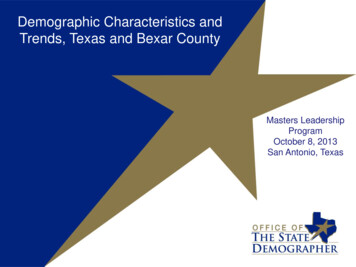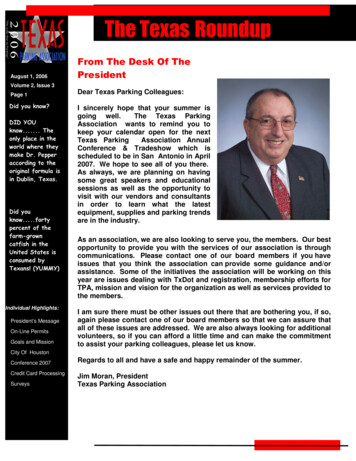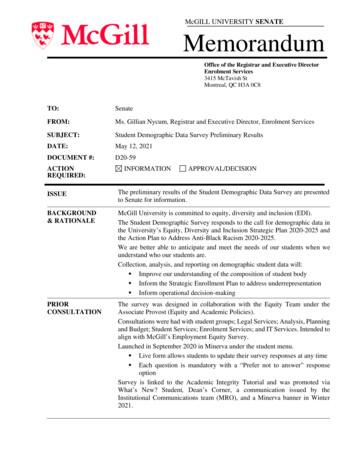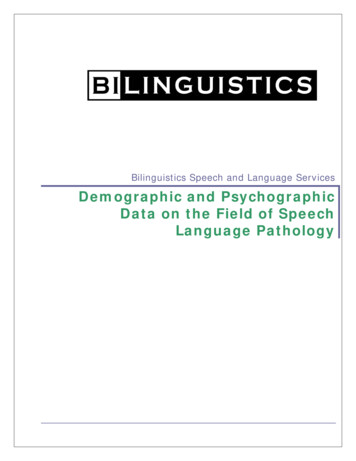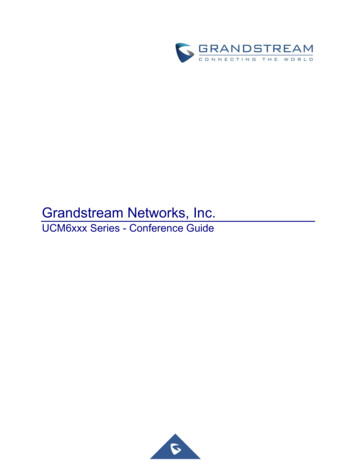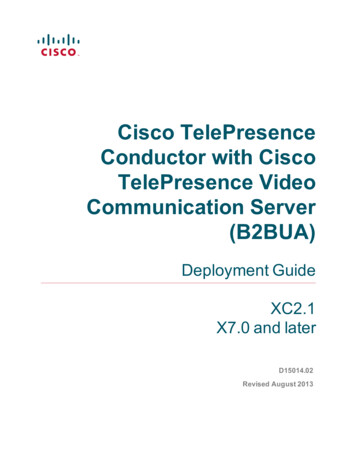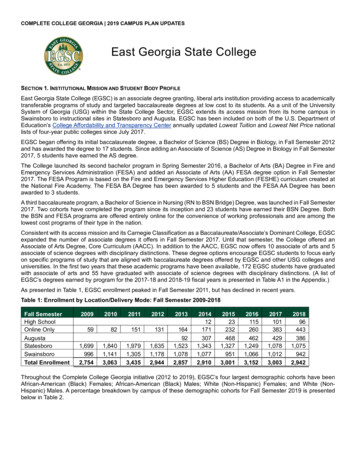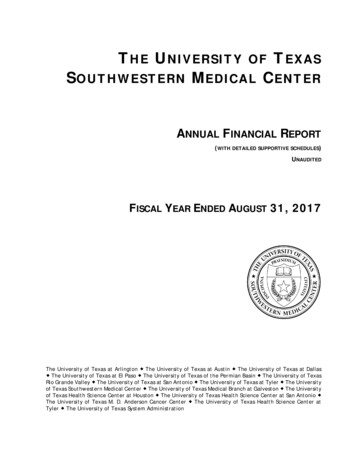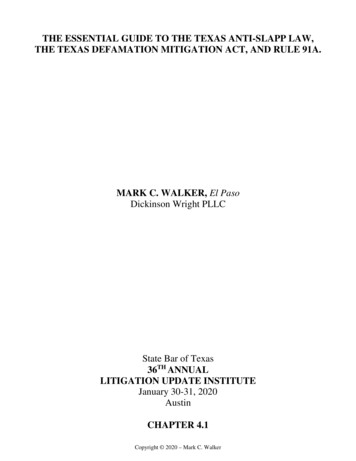
Transcription
2019 Texas Demographic ConferenceThompson Conference CenterAustin, TexasJune 5-6, 2019
Our SponsorsSpecial Thanks to Our Sponsors,Hosts & Planning Committee!Support Staff:Janine Geppert, Texas Demographic CenterLisa Espinoza, The Institute for Demographic and Socioeconomic ResearchMelisa Perez-Treviño, Texas Demographic CenterTechnical Support:Alfredo Zavala, Texas Demographic CenterEric Quiroz, Texas Demographic Center
Conference Agenda . 5Conference Keynote . 10Presentation Descriptions . 11Speaker Information. 17Attendee List . 34Let’s get Social!TexasDemographics@TexasDemographyPlease tag any social media posts: #2019TDC #2020Census4
Conference AgendaDay One: Workshops and Training (June 5th)Participants may bring a laptop to better experience the examples provided in training sessions during both days ofthe conference. Wireless Internet access is available to all UT campus visitors on the UTGuest network.7:30 – 8:00 a.m.Registration (1st Floor Lobby) and Continental Breakfast – 2.1028:00 – 9:50 a.m.Plenary Session: Census Bureau and TDC Data and Product Updates – 2.102Moderator: Lila Valencia, Texas Demographic CenterCensus 2020 at a GlanceLloyd Potter, State DemographerTexas Demographic Center Data and Product UpdateLila Valencia, Texas Demographic CenterAccessing Census Data in 2019: The Transition to data.census.govKaNin Reese, Dissemination Outreach Branch Chief at Census Bureau9:50 – 10:00 a.m.Break and Networking – 2.10210:00 – 10:50 a.m.Track 1: Complete Count Committees(2.110)Introduction to Complete CountCommitteesMaría Isabel Campos, U.S. CensusBureau11:00 – 11:50 a.m.BYODTrack 2: Data Tools and DataVisualizations(2.120)Moderator: Janine GeppertIPUMS Data for Population and PolicyResearchJonathan Schroeder, University ofMinnesotaKari Williams, University of MinnesotaTrack 1: Complete Count CommitteesModerator: Helen You(2.110)Forming a Complete CountCommittee in Your CommunityMaría Isabel Campos, U.S. CensusBureauBYODModerator: Janine Geppert12:00 – 12:50 p.m.Lunch and Lightning Round – 2.102Participants are encouraged to share their current products and/or discusstheir data needs.Moderator: Lila ValenciaBYODBRING YOU OWN DEVICE: Par cipants are encouraged to bring a laptop to be er experience these sessions.5
Conference AgendaDay One: Workshops and Training (June 5th - continued)1:00 – 1:50 p.m.2:00 – 2:50 p.m.Track 1: Complete Count Committees(2.110)How to Use a Low Response Score toReach Hard to Count CommunitiesMacy Hurwitz, U.S. Census BureauTrack 2:(2.120)Update on Geographic Area Programsfor the 2020 CensusMichael Ratcliffe, U.S. Census BureauModerator: Janine GeppertModerator: Jeff JordanBYODTrack 1: Complete Count Committees(2.110)Census Solutions Workshop, Part 1Rebecca Briscoe, U.S. CensusBureauModerator: Janine GeppertTrack 2: Data Tools and DataVisualizations*(2.120)Using Census Data to Power YourVisualizations, Part 1Ryan Dolan, U.S. Census BureauGerson Vasquez, U.S. Census Bureau*Free Tableau Public download availableat: h r: Lila Valencia2:50 – 3:00 p.m.Break and Networking – 2.1023:00 – 3:50 p.m.Track 1: Complete Count Committees(2.110)Census Solutions Workshop, Part 2Rebecca Briscoe, U.S. CensusBureauModerator: Janine GeppertBYODTrack 2: Data Tools and DataVisualizations*(2.120)Using Census Data to Power YourVisualizations, Part 2Ryan Dolan, U.S. Census BureauGerson Vasquez, U.S. Census Bureau*Free Tableau Public download availableat: h r: Lila ValenciaBYOD4:00 – 5:00 p.m.TDC Affiliates Meeting – 2.1206:00 p.m.Group Dinner — Meet at hotel lobby or restaurant for a “going Dutch” dinnerat Sour Duck. www.sourduckmarket.comBYODBRING YOU OWN DEVICE: Par cipants are encouraged to bring a laptop to be er experience these sessions.6
Conference AgendaDay Two: Main Conference (June 6th)7:30 – 8:00 a.m.Registration (1st Floor Lobby) and Continental Breakfast – 2.1028:00 – 9:45 a.m.Plenary Session – 2.102Moderator: Lloyd Potter, Texas State DemographerA Look Ahead: Population Projections for Texas and Its CountiesHelen You, Senior Demographer, Texas Demographic Center2020 Census: The Texas CountCathy Lacy, Denver Regional Director, U.S. Census Bureau9:45 - 10:00 a.m.Break and Networking – 2.10210:00 - 10:50 a.m.Track 1(2.120)Counting All Texas Kids in 2020Eric Jensen, U.S. Census BureauJose Carrillo, National Association ofLatino Elected and AppointedOfficials (NALEO)Frances Deviney, Center for PublicPolicy PrioritiesTrack 2(2.110)Census Barriers, Attitudes, andMotivators Study FindingsMonica Vines, U.S. Census BureauModerator: Janine GeppertModerator: Lloyd Potter11:00 -11:50 p.m.Plenary Session – 2.102Census 2020: What’s at Stake for Texans?Video Introduction by Cassie Davis, Center for Public Policy PrioritiesCory Green, Texas Education AgencySuling Homsy, Health and Human Services CommissionLara Lamprecht, Department of State Health ServicesMarc Williams, Texas Department of TransportationModerator: Lila Valencia12:00 -1:25 p.m.Keynote – 2.102Current and Projected Patterns of Future Population and RelatedSocioeconomic Change in Texas and the United StatesSteve Murdock, former U.S. Census Bureau Director and first Texas StateDemographerIntroduction by Lloyd Potter, Texas State Demographer7
Conference AgendaDay Two: Main Conference (June 6th - continued)1:35 - 2:35p.m.Plenary Session – 2.102Advancing Efforts Towards a Texas Complete CountAnn Beeson, Center for Public Policy PrioritiesState Representative César Blanco, El Paso House District-76Lloyd Potter, Texas State Demographer2:40 - 3:35p.m.Track 1:(2.120)Texas DemographicCenter Projections: StateAgency ApplicationsYun Cho, Texas WaterDevelopment BoardEdli Colberg,Department of Healthand Human ServicesRafael Gonzalez, TexasWorkforce InvestmentCouncilChelsea Moore, TexasHigher EducationCoordinating BoardTrack 2:(2.110)Census 2020: The Role ofthe MediaAmbar Calvillo-Rivera,Voto LatinoFely Garcia, UnivisionAshley Lopez, KUT NewsModerator: Pauline Nuñez,U.S. Census BureauModerator: Helen YouTrack 3: Spatial Analysisusing GIS(2.122)Invisible Limits? HowFederal AffordableHousing Policy ShapesAccess to School QualityJennifer Jellison Holme,The University of Texas atAustinJoanna D. Sanchez,Excelencia in EducationMichelle Kennedy, TheUniversity of Texas atAustinSarah de la Garza, TheUniversity of Texas atAustinChanging Texas: Trendsover Time in RuralPopulations andLandscapesMatthew Crawford,Texas A&M NaturalResources InstituteAlison A. Lund, TexasA&M Natural ResourcesInstituteModerator: Jeff Jordan3:35 - 3:45p.m.Break and Networking – 2.1028
Conference AgendaDay Two: Main Conference (June 6th - continued)3:45 – 4:40 p.m.Track 1:(2.120)Counting Texas CommunitiesBruce Elfant, Travis CountyRobert Heyman, Border Network forHuman RightsErika Reyna, Hidalgo CountyModerator: Lila ValenciaTrack 2:(2.110)Counting College StudentsChristian Botello, The University ofTexas at El PasoVeronica Gonzales, The University ofTexas Rio Grande ValleyMolly Beth Malcolm, AustinCommunity CollegeModerator: Paulina Lopez, U.S. CensusBureau4:45 – 5:00 p.m.Meeting Adjournment – 2.1209
Conference KeynoteKEYNOTEThursday, June 6, 2019Population Change in Texas: Implications of Current and FutureDemographic Change for the Size, Characteristics, and Location ofDemographic and Related Socioeconomic Change in TexasSteve H. Murdock, Ph.D.Director at the Center for the Study of Texas at Rice UniversityIn his address, Dr. Murdock will examine current and future demographic change for the future of Texas. Thisincludes an examina on and discussion of the challenges and opportuni es resul ng from such changes both nowand in the future.Dr. Murdock is the Allyn and Gladys Cline Professor of Sociology at Rice University. In addi on he has served asThe Director of the United States Census Bureau, on the faculty at Texas A&M University, the University of Texas atSan Antonio, and North Dakota State University. He is the author of 16 books and more than 100 journal ar cles andnumerous reports of the implica ons of current and future pa erns of popula on change.10
Presentation DescriptionsDay One: Workshops and Training (June 5th)Census 2020 at a GlanceLloyd Po er ‐ Texas State DemographerThe importance of the 2020 Census goes well beyond appor onment and return of federal resources to Texas.Census data are used for redistric ng and also serve as the demographic founda on of post‐census popula ones mates and projec ons. There are a number of changes to how the census will be conducted and will likely besome significant changes in how census data are released. TDC and others have been involved in efforts thatinclude upda ng address lists and reviewing geographic boundaries for sta s cal repor ng. These andaddi onal topics will be addressed in this session.Texas Demographic Center Data and Product UpdatesLila Valencia ‐ Senior Demographer, Texas Demographic CenterThe Texas Demographic Center processes an average of 600 requests for data, presenta ons, expert tes mony,media interviews, and custom analyses every year. We aim to be the lead demographic data source for thestate. To that end, we work diligently to provide you with the best, most accurate, and objec ve data we caniden fy. In this session, we will provide informa on on updates to our core data products from our Popula onEs mates and Projec ons Program and complimentary products. We will also present some newly availableresources ahead of the 2020 census.Accessing Census Data in 2019: The Transi on to data.census.govKaNin Reese ‐ Chief of Dissemina on Outreach Branch, U.S. Census BureauA er con nuously developing a new way of accessing data over the past few years, we are now a few monthsaway from the re rement of American FactFinder and official launch of data.census.gov. With no new releasesin American FactFinder a er June 2019, this pla orm will be the primary way to access data from the 2018American Community Survey, 2017 Economic Census, 2020 Census, and more! Join this webinar to see a livedemonstra on of the latest updates and learn how to access data from the new site.Introduc on to Complete Count Commi eesMaría Isabel Campos ‐ Partnership Specialist, U.S. Census BureauThe road to a successful Census 2020 starts with complete count commi ees (CCC). Complete CountCommi ees are one of the core strategic elements of the Census Bureau’s partnership program for the 2020census. These commi ees exist to plan and implement locally based outreach campaigns that raise awarenessof the census and increase self response and par cipa on rates. This session will provide an introduc on to thebackground and structure of complete count commi ees.Forming a Complete Count Commi ee in Your CommunityMaría Isabel Campos ‐ Partnership Specialist, U.S. Census BureauOne of the key reasons Complete Count Commi ees are effec ve in raising awareness and par cipa on in thecensus is because of member’s knowledge, networks, and understanding of what it takes to engage and inspireothers within their community. This session will cover how to form a complete count commi ee, fromiden fying diverse community leaders and partners to providing an environment that encourages open11
Presentation DescriptionsDay One: Workshops and Training (June 5th)communica on and brings out members’ unique skills and talents. The CCC’s are especially important in areasthat have been historically harder to count due to various barriers that may exist. CCC’s can help to alleviatethese barriers to ensure no one is le out of the census.IPUMS Data for Popula on and Policy ResearchJonathan Schroeder, Ph.D. ‐ Geographer, University of MinnesotaKari Williams ‐ Senior Data Analyst, University of MinnesotaIPUMS integrates census and survey microdata from around the world across me and space, and offers thesedata and related IPUMS services to users free of charge. This workshop will describe the data collec ons andresources available through IPUMS and summarize the topical, temporal, and geographic coverage of the IPUMSdata collec ons. The first half of the workshop will include demonstra ons of the IPUMS microdata access systemand online analysis tools available at h ps://ipums.org. The second half of the workshop will cover geographicdata resources available in IPUMS collec ons, including GIS files, summary tables, and specialized microdataproducts.How to Use a Low‐Response Score to Reach Hard‐to‐Count Communi esMacy D. Hurwitz ‐ Partnership Specialist, U.S. Census BureauThe Response Outreach Area Mapper, or ROAM, is a tool Complete Count Commi ees can use to find hard‐to‐county popula ons in their communi es. This session will explain how the low‐response score is calculated andwhat CCCs can do to target their outreach to the places it is needed most.Update on Geographic Area Programs for the 2020 CensusMichael Ratcliffe ‐ Assistant Division Chief for Geographic Standards, Criteria, Research, and Quality, GeographyDivision, U.S. Census BureauGeography provides relevance and meaning for sta s cal data. As such, it is important that we update theuniverse of, and boundaries for, geographic areas prior to each decennial census. In this presenta on, I willprovide an update on geographic area programs for the 2020 Census, including informa on about censusdesignated places and colonias. I also will provide an update on research and consulta ons related to variousways to define rural and urban areas.Census Solu ons WorkshopRebecca Briscoe ‐ Partnership Coordinator, U.S. Census BureauA Census Solu ons Workshop can help address census challenges in a highly‐engaging and innova ve formatthrough a series of problem solving exercises. Par cipants generate new ideas with an approach that emphasizesempathy and is customized to the needs of the real people they are engaging. Those new ideas lead to real,ac onable commitments, helps partners to be er understand their audience, and forge new public‐privatepartnerships.12
Presentation DescriptionsDay One: Workshops and Training (June 5th)Using Census Data to Power Your Visualiza onsRyan Dolan‐ Data Visualiza on Lead, U.S. Census BureauGerson Vasquez ‐ Data Visualiza on Lead, U.S. Census BureauVisualizing data can help you reach a broader audience, more effec vely communicate sta s cal informa on,and discover hidden pa erns. This presenta on will cover important Census data access steps, and give examplesof good prac ces when crea ng your own data visuals. The presenters will also take you behind the scenes onexis ng visualiza ons on census.gov, as well as seek your expert input on poten al future projects.This session is designed to be interac ve, and will showcase visualiza on examples within Tableau So ware.A endees may choose to ‘look and learn’ or follow along on their own computer. Those who do not have TableauDesktop so ware may choose to download a fully func oning, FREE version of Tableau Public.h ps://public.tableau.com/en‐us/s/downloadA Look Ahead: Popula on Projec ons for Texas and Its Coun esHelen You ‐ Senior Demographer, Texas Demographic CenterI will provide a brief introduc on to the methods and data used in the newly released 2018 TDC popula onprojec ons. I will also highlight future demographic trends in Texas and its coun es summarized from theseprojec ons. Future plans for the TDC projec on programs will be discussed as well.2020 Census: The Texas CountCathy L. Lacy, Denver Regional Director, U.S. Census BureauThis plenary will give an update of 2020 Census opera ons and outreach in the state of Texas. Recent popula ones mates showed that Texas took four of the top ten spots in numeric growth. Cathy will discuss the firstopera on of the 2020 Census which begins this fall, recrui ng in a prosperous state, and the importance of stateand local leaders involvement.Census Barriers, A tudes, and Mo vators Study FindingsMonica Vines ‐ Lead Researcher for Communica ons, U.S. Census BureauThe U.S. Census Bureau conducted the 2020 Census Barriers, A tudes, and Mo vators Study (CBAMS), whichconsisted of a 61‐ques on survey and 42 focus groups, to understand what might mo vate or prevent peoplefrom comple ng the 2020 Census. Results are informing the crea ve strategy for the 2020 Census IntegratedPartnership and Communica ons Program. The survey, conducted between February 20 and April 17, 2018, wasmailed to a sample of 50,000 households across all 50 states and DC. Adults 18 or older were eligible to respondvia the internet or mail in either English or Spanish. Approximately 17,500 people responded, resul ng in aweighted response rate (AAPOR Response Rate 3) of 39.4 percent. Addi onally, we reached several hard‐to‐countpopula ons through qualita ve research within a similar me period to garner ac onable insights to guidetargeted outreach. This presenta on covers the high level findings of both efforts.13
Presentation DescriptionsDay Two: Main Conference (June 6th)Coun ng All Kids in 2020Eric Jensen ‐ Senior Technical Expert for Demographic Analysis, Popula on Division, U.S. Census BureauJose Carrillo ‐ Director of Strategic Ini a ves, Na onal Associa on of La no Elected and Appointed Officials (NALEO)Frances Deviney, Ph.D. ‐ Chief Opera ng Officer, Center for Public Policy Priori esAn es mated 2.2 million children under the age of 5 were not counted in the 2010 census, including about 75,000Texas children. Our expert panel will discuss the latest research findings that further describe the issue, what theCensus and its partners are doing ahead of 2020 to ensure an improved count of young children, and theimplica ons of an undercount of Texas young children.Census 2020: What’s at Stake for TexasCory Green ‐ Associate Commissioner, Contracts, Grants, and Financial Administra on, Texas Educa on AgencySuling Homsy, Ph.D. ‐ Senior Policy Advisor, Texas Health and Human Services CommissionLara Lamprecht, Ph.D. ‐ Assistant Deputy Commissioner, Texas Department of State Health ServicesMarc Williams ‐ Deputy Execu ve Director, Texas Department of Transporta onOnce each decade, the country comes together to count every person residing in the United States. Data fromthis count are used in the distribu on of over 675 billion in federal funds, grants, and support to states, coun es,communi es. In this session, we will summarize research by Dr. Andrew Reamer, tled “Coun ng for Dollars”,that es mates the role the 2020 Census will play in the distribu on of federal funding, in par cular funding forTexas programs. Our expert panel will describe some of their programs derived from census data, what servicesthese programs provide, and poten al implica ons of an undercount in 2020.Advancing Efforts Toward a Texas Complete CountAnn Beeson ‐ Chief Execu ve Officer, Center for Public Policy Priori esState Representa ve César Blanco ‐ El Paso HD‐76Lloyd Po er ‐ Texas State DemographerNumerous individuals and organiza ons have an interest in ensuring that we count all people residing in Texas.This session will review complete count efforts in Texas to date, strategies to advance a complete count, andopportuni es to become engaged in complete count efforts.Texas Demographic Center Popula on Projec ons: State Agency Applica onsYun Cho ‐ Manager, Economic and Demographic Analysis Sec on, Texas Water Development BoardEdli Colberg, Ph.D. ‐ Department of State Health ServicesRafael Gonzalez ‐ Research Specialist, Texas Workforce Investment Council, Office of the GovernorChelsea Moore, Ph.D. ‐ Program Director, Strategic Planning, Texas Higher Educa on Coordina ng BoardHelen You, Ph.D. ‐ Senior Demographer, Texas Demographic CenterIn this session, we will showcase works and studies from several state agencies. The panel will then focus on adiscussion around the applica ons of the TDC popula on projec ons program, its u lity and limits, and providesugges ons for other users as well as for future improvements. Audience par cipa on is encouraged.14
Presentation DescriptionsDay Two: Main Conference (June 6th)Census 2020: The Role of the MediaAmbar Calvillo‐Rivera ‐ Voto La noFely Garcia ‐ Community Empowerment, UnivisionAshley Lopez ‐ KUT NewsPauline Nuñez ‐ Partnership Coordinator, U.S. Census BureauThe media have historically played a cri cal role in educa on and outreach around the decennial census. Thereare a number of changes to how the census will be conducted, including allowing online responses for the firstme ever. In this session, we will discuss the role the media can play in dissemina ng informa on about thesechanges, reaching hard to count popula ons, and repor ng on poten ally cri cal issues in this census, such asdata confiden ality and response op ons.Invisible Limits? How Federal Affordable Housing Policy Shapes Access to School QualityJenniferJellison Holme, Ph.D ‐ The University of Texas at Aus nJoanna D. Sánchez, Ph.D. ‐ Excelencia in Educa onMichelle Kennedy, The University of Texas at Aus nSarah de la Garza, The University of Texas at Aus nThis paper uses GIS to illuminate the rela onship between federal housing assistance u liza on by families in 5Texas metro areas and educa onal opportunity, to be er understand the ways in which housing policy shapesaccess to schools of opportunity for low income families‐‐ schools that are high performing and that are rich inresources for learning. We specifically map the loca on of Low Income Housing Tax Credit proper es andfederally funded public housing by school a endance zones, by elementary, middle and high school. To measureschool quality, we look not only at proficiency scores, but we also examine school segrega on, povertyconcentra on, and other indicators of educa onal opportunity, including teacher experience and educa onlevels.Changing Texas: Trends over Time in Rural Popula ons and LandscapesMa hew Crawford ‐ GIS Specialist, Texas A&M Natural Resources Ins tuteTexas Land Trends is an ongoing project conducted by the Texas A&M Natural Resources Ins tute. Every fiveyears, following the availability of the USDA NASS Census of Agriculture data, the Texas Land Trends teamcombines and analyzes the census results with several important datasets, from sources such as the TexasComptroller of Public Accounts and the Texas Demographic Center, to describe the status and recent changes inland use, land ownership size and land values of privately owned Texas farms, ranches, and forests, collec velyknown as working lands. The project also focuses on the state’s growing popula on and changing rurallandowners, highligh ng landowner factors such as age, land residency, and land use preferences, all of which cangreatly impact the future of our state’s rich open spaces and natural resources for genera ons to come.15
Presentation DescriptionsDay Two: Main Conference (June 6th)Coun ng College StudentsChris an Botello ‐ President, Student Government Associa on, The University of Texas at El PasoVeronica Gonzales ‐ Vice President for Governmental and Community Rela ons, The University of Texas Rio GrandeValleyMolly Beth Malcolm, Ph.D. ‐ Execu ve Vice‐President for Campus Opera ons and Public Affairs, Aus n CommunityCollegePaulina Lopez ‐ Partnership Specialist, U.S. Census BureauCollege students o en share characteris cs of a number of hard to count popula ons iden fied by Census Bureauresearch. They are highly mobile, o en renters, live in larger, unrelated households, and can o en have very lowincomes, making census par cipa on a real challenge. In this session, panelists will describe efforts underway attheir colleges and universi es, and how they plan to take on the challenge of coun ng this hard to countpopula on.Coun ng Texas Communi es: Local Complete Count Commi eesBruce Elfant ‐ Tax Assessor, Travis CountyRobert Heyman ‐ Border Network for Human RightsErika Reyna ‐ Hidalgo CountyLocal complete count commi ees are essen al in decennial census efforts. Their understanding of the uniquechallenges and opportuni es in their communi es makes them valuable partners and effec ve trusted voices inencouraging census par cipa on. In this session, panelists will describe efforts planned and underway in theirlocal communi es.16
Speaker InformationAnn Beeson ‐ Chief Execu ve Officer, Center for Public Policy Priori esA renowned social jus ce lawyer, former philanthropy execu ve, and frequent publicspeaker and writer, Ann Beeson joined the Center in 2013. She was previously theExecu ve Director of U.S. Programs at the Open Society Founda ons, where shepromoted human rights, jus ce, and accountability na onwide. Beeson was the na onalAssociate Legal Director of the American Civil Liber es Union, where she worked from1995‐2007. She argued twice before the U.S. Supreme Court, li gated numerous casesaround the country, and launched groundbreaking programs to stop the erosion of civilliber es in the name of na onal security and to protect free speech and privacy on theInternet. Beeson has been recognized as one of the na on’s top lawyers by American Lawyer Magazine andthe Na onal Law Journal. A proud Texan, Beeson has embraced a wide range of innova ve strategies to advancesocial change. Before joining the Center, she launched a new non‐profit to involve the crea ve sector in socialchange. In 2012‐13, she was a Senior Fellow and Lecturer at the Anne e Strauss Ins tute for Civic Life at theUniversity of Texas, where she co‐produced a public media series to inspire more people to get engaged in theircommuni es. She grew up in Dallas, Texas, and received undergraduate and graduate degrees from the Universityof Texas. Beeson obtained her law degree from Emory University School of Law, and served as law clerk to theHonorable Barefoot Sanders, then chief judge of the Northern District of Texas.Cris an Botello ‐ President of Student Government Associa on, The University of Texasat El PasoCris an serves as the President of the University of Texas at El Paso StudentGovernment Associa on where he represents 25,000 students at the university, city, andstate level. He has advocated on topics related to access to affordable pharmaceu caldrugs on campus and increase u liza on of educa onal technologies from faculty andstudents.Through serving on the UT system student advisory council and as a member of theUTEP presiden al search commi ee, Cris an brings a wide range of experiences fromhigher educa on. Cris an is earning a Bachelor of Arts in sociology with a minor ingeneral business. Cris an is passionate about serving his home community and hopes tocon nue doing so by becoming a healthcare administrator and running for office.17
Speaker InformationCésar Blanco ‐ State Representa ve, House District 76 ‐ El PasoRepresenta ve César J. Blanco represents District 76 in El Paso. This is his second termas Chairman of the Texas House Border Caucus and his first term as Whip for the TexasHouse Democra c Caucus. He was appointed Vice‐Chairman of the Defense & Veterans'Affairs Commi ee and also serves on the Land & Resource Management Commi ee.Rep. Blanco followed a long family tradi on of serving his country in the U.S. Navy. A erserving in the Navy, Rep. Blanco earned his degree at UTEP with the help of the G.I. Bill.Rep. Blanco is currently the Vice President of the La no Development Program and isthe former Poli cal Director for La no Victory Project. Rep. Blanco was also the ArizonaState Director for President Obama's 2012 Reelec on Campaign and has also served asthe Chief of Staff for several U.S. Congressman in Washington D.C. Rep. Blanco is amember of the American Legion, and the American G.I. Forum Paso Del Norte Chapter.He serves on the Execu ve Commi ee of the El Paso Metropolitan Planning Organiza on is a former board memberof Big Brothers Big Sisters of El Paso, an honorary board member of the Medical Center of the Americas Founda onin El Paso, and serves on the Execu ve Commi ee of the El Paso Metropolitan Planning Organiza on.Rep. Blanco advocates for our community's economic security through increased opportuni es in workforcedevelopment and educa on. He also supports increasing access to health care and figh ng for Veterans rights andbenefits.Rebecca M. Briscoe ‐ Partnership Coordinator, U.S. Census Bureau, Dallas RegionalCensus Center/Field Division/Denver RegionRebecca Briscoe is a Partnership Coordinator for the United States Census Bureau‐Denver Region. Rebecca is responsible for developing partnerships with state and localgovernments, community based organiza ons, faith‐based organiza ons, schools, mediaoutlets, businesses, and grassroots en es.Rebecca has over a decade of experience working in the public sector as a: publicadministrator, cer fied educator in tle one schools, and as an adjunct professor inhigher educa on. Rebecca is an avid writer with strong na onal media affilia ons andpublicity es.She holds a BS in Educa on from Louisiana State University, a Masters in PublicAdministra on from the Barbara Jordan and Mickey Leland School of Public Affairs atTexas Southern University, and a post‐graduate cer ficate in Homeland Security fromthe Bush School of Government and Public Service at Texas A&M University.18
Speaker InformationAmbar Calvillo‐Rivera ‐ Vice President of Campaigns, Voto La noAmbar Calvillo‐Rivera is the Vice President of Campaigns at Voto La no, a pioneeringcivic media organiza on shaking up the poli cal establishment to bring La nx youthvoices into the democra c process. Ambar is a na ve of El Paso, Texas and received herundergraduate degree from the University of Texas at El Paso. She a ended theUniversity of New Mexico, earning a master’s degree in Educa onal Leadership. Prior tojoining Voto La no, she worked on local strategies that invest in the children of El PasoCounty and their families, as the Director of Community Impact for the United
Accessing Census Data in 2019: The Transition to data.census.gov KaNin Reese, Dissemination Outreach Branch Chief at Census Bureau 9:50 - 10:00 a.m. Break and Networking - 2.102 . Gerson Vasquez, U.S. Census Bureau *Free Tableau Public download available at: hps: .

